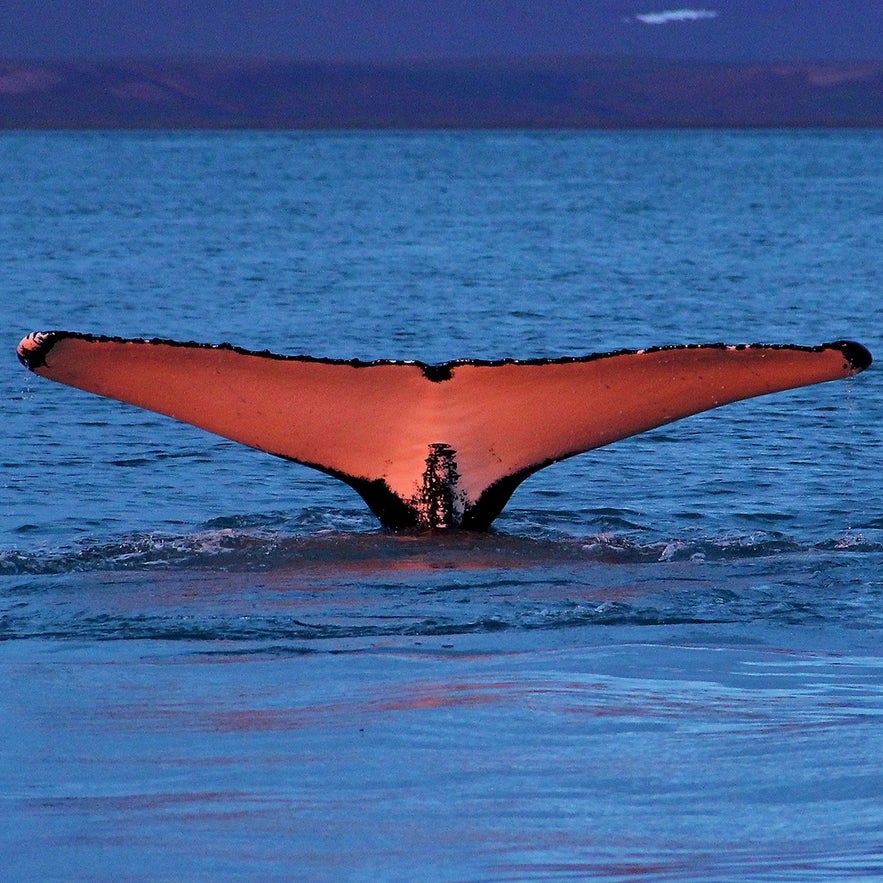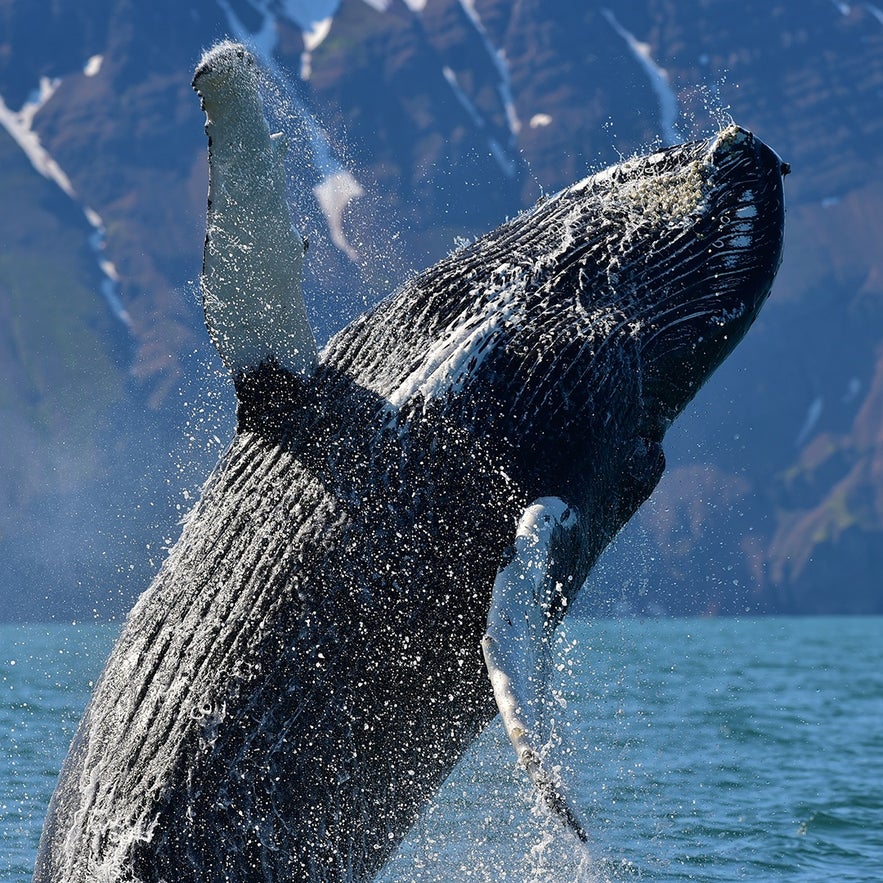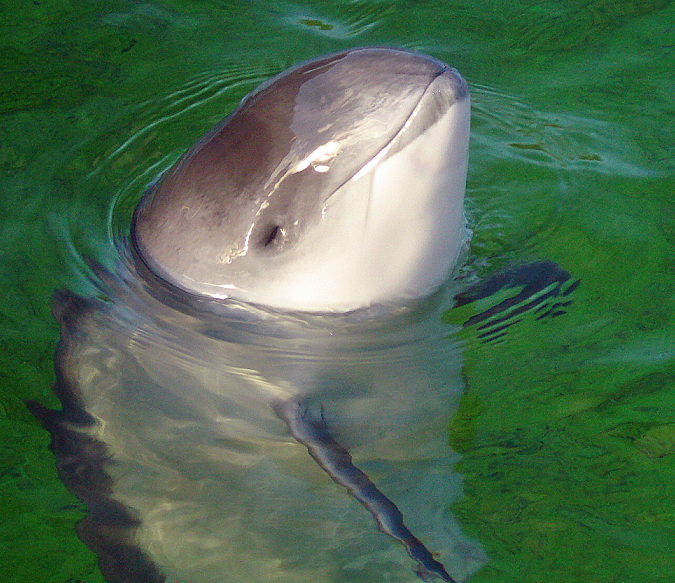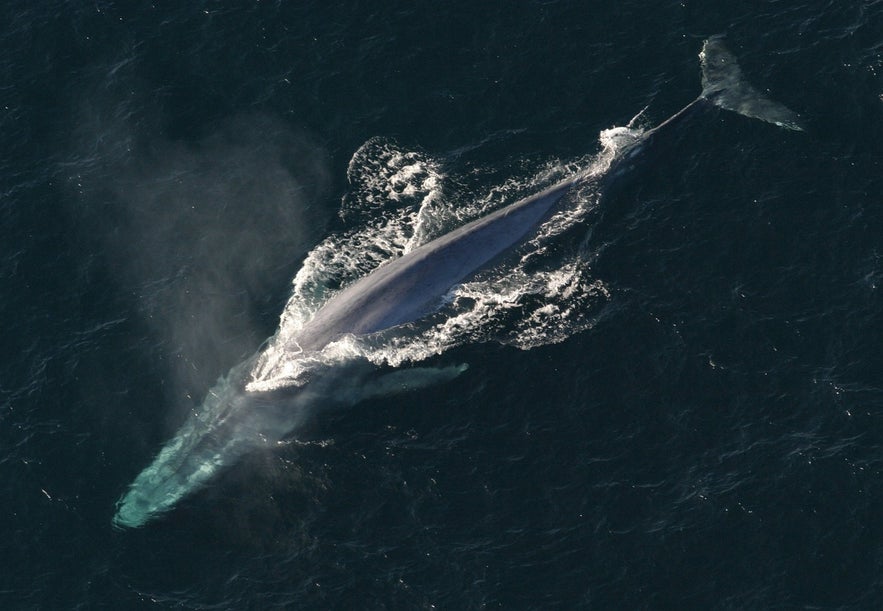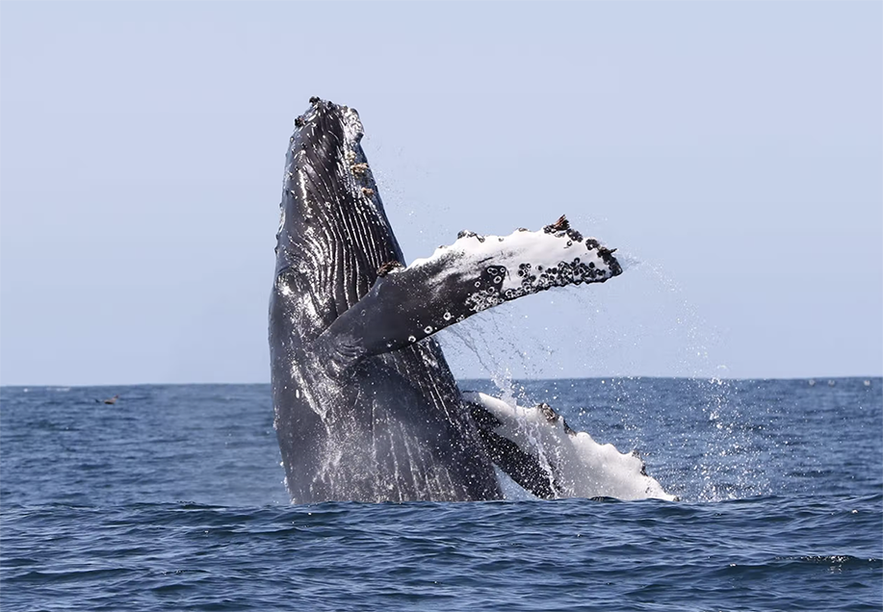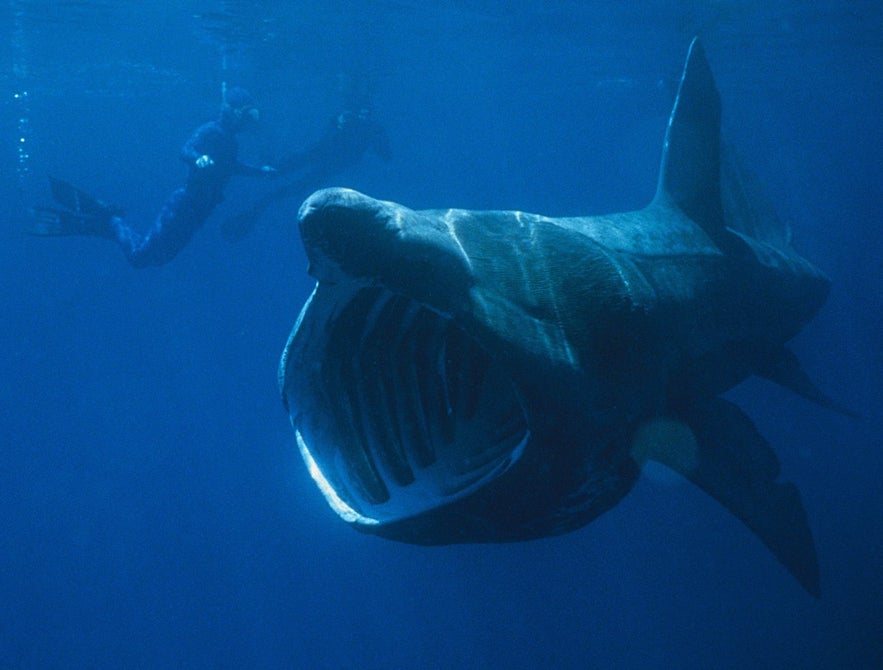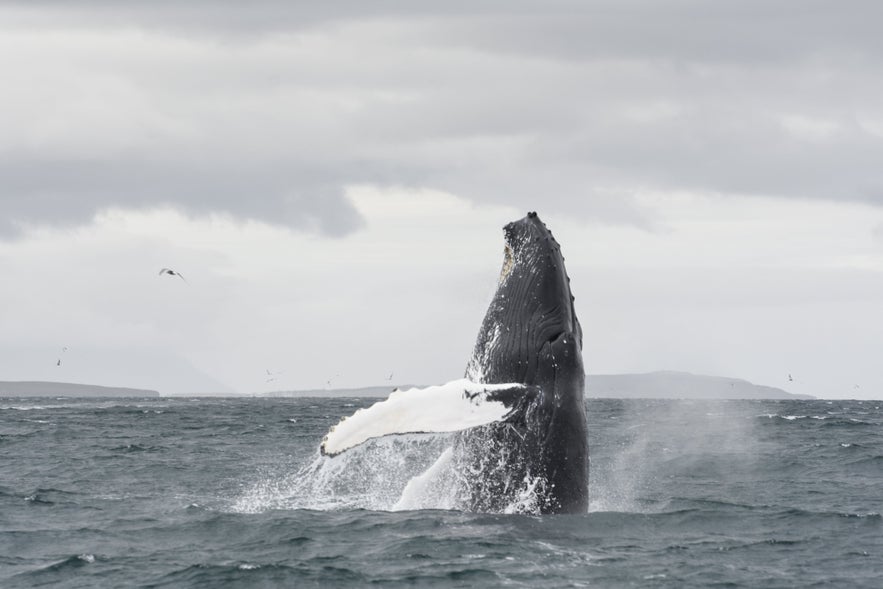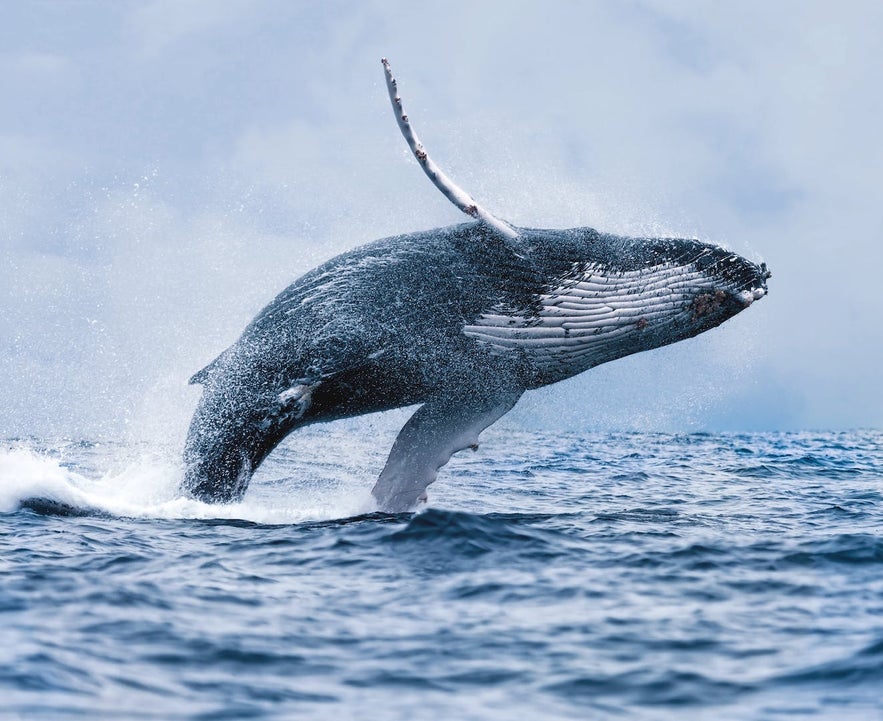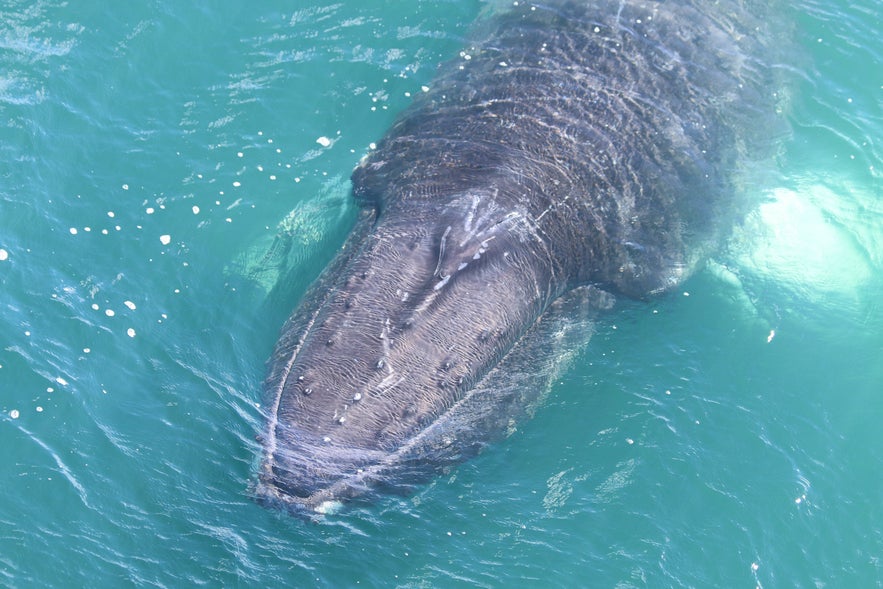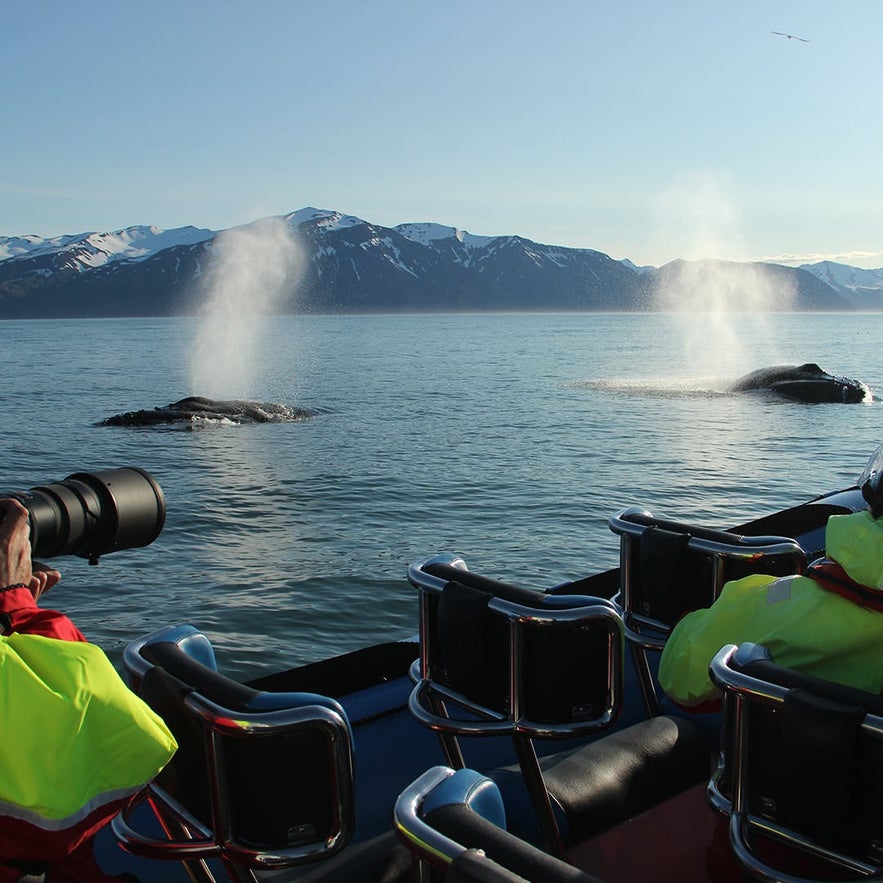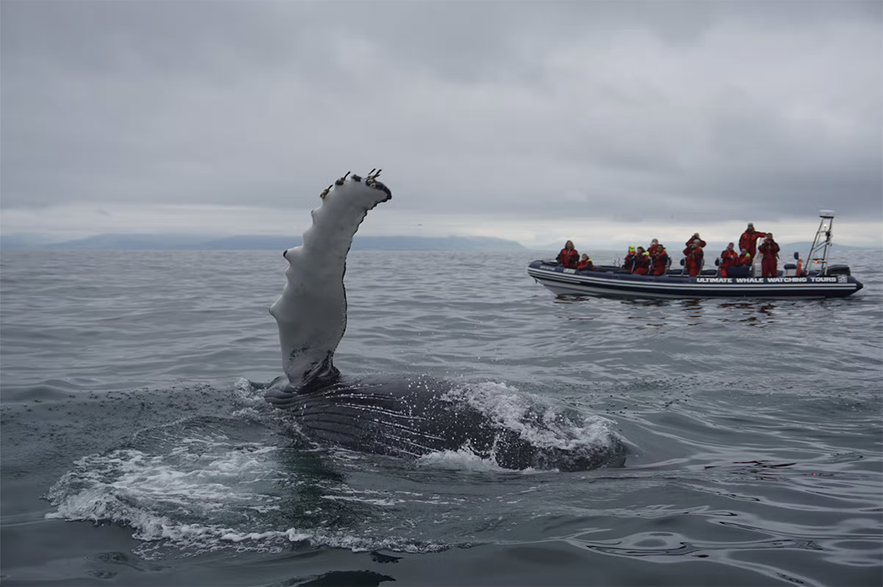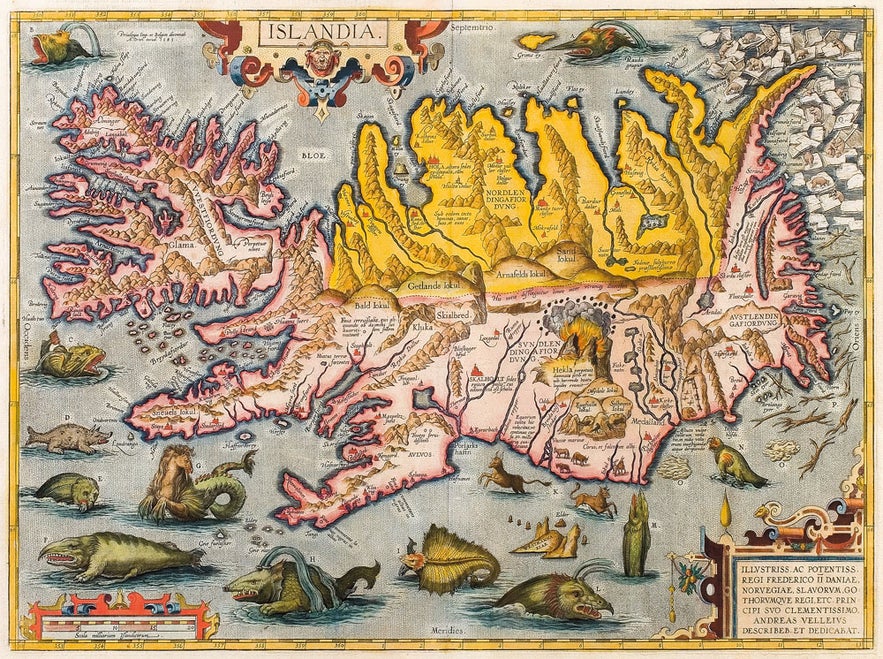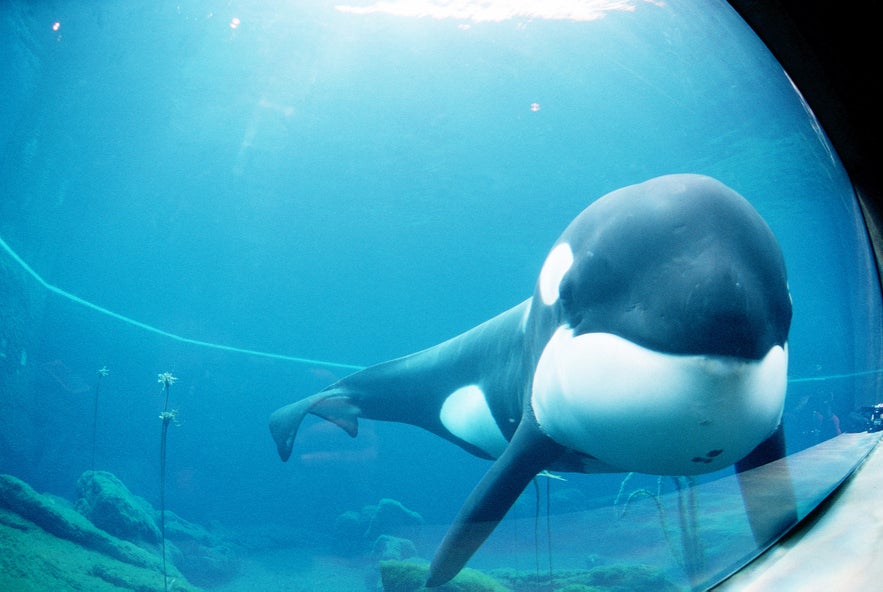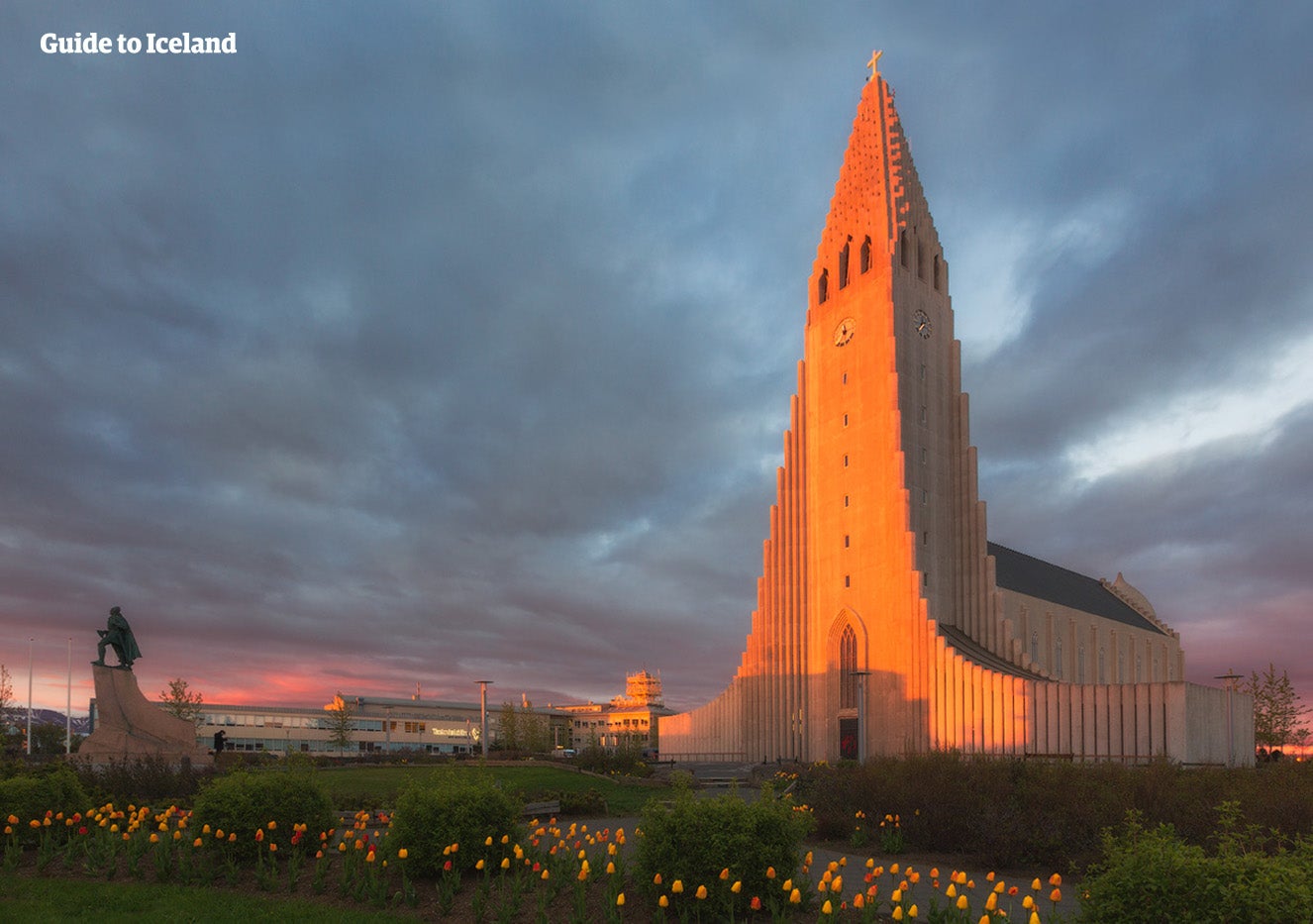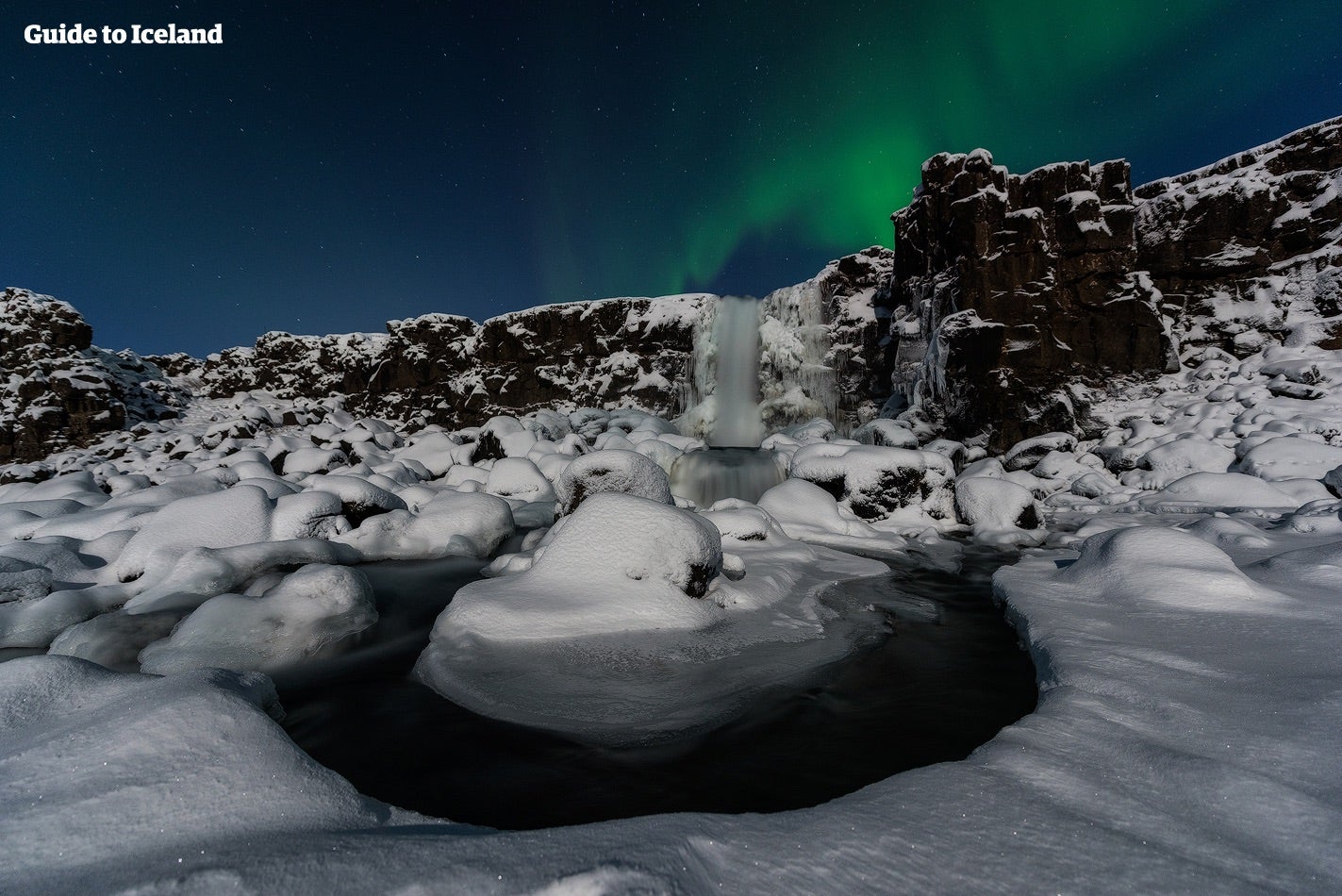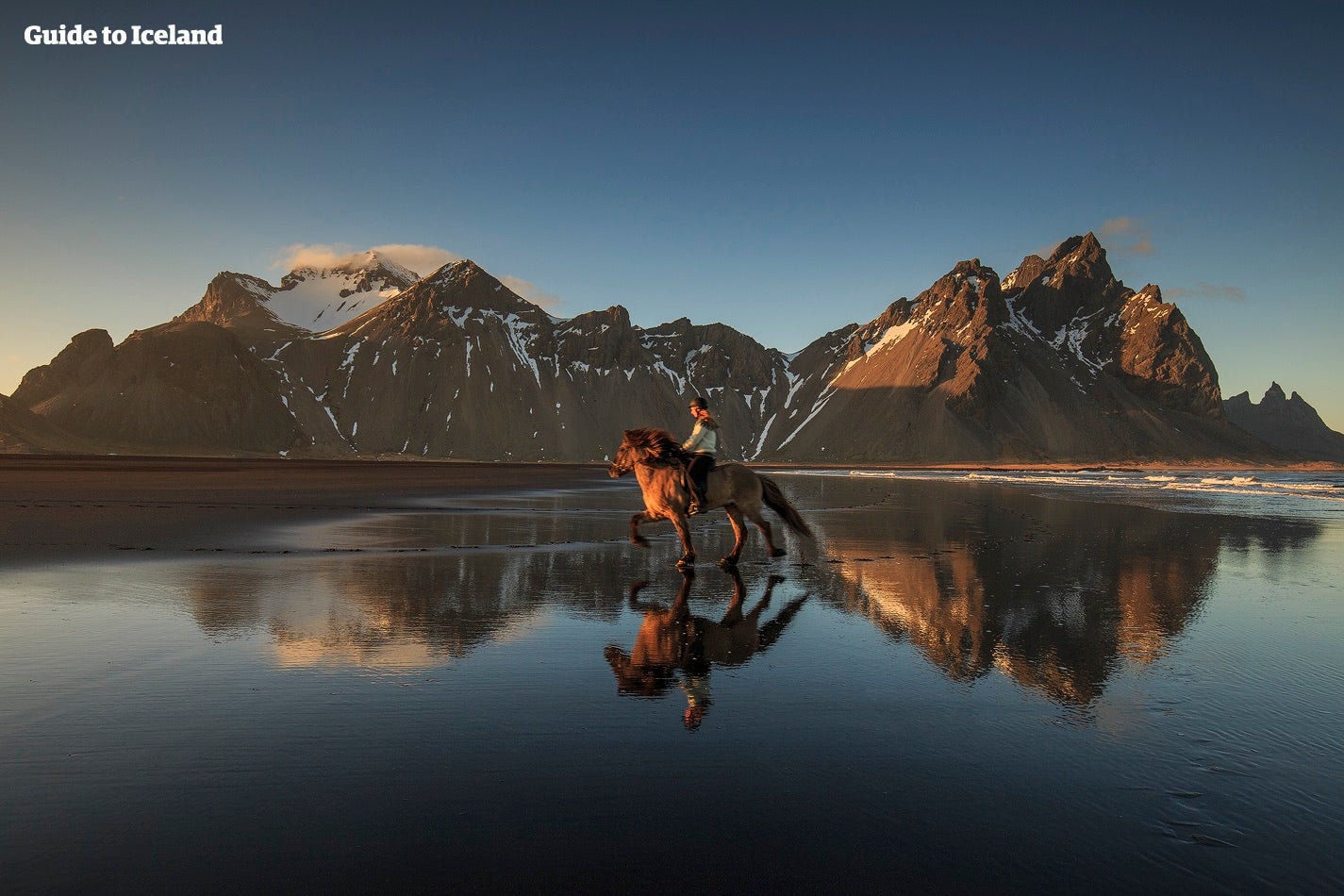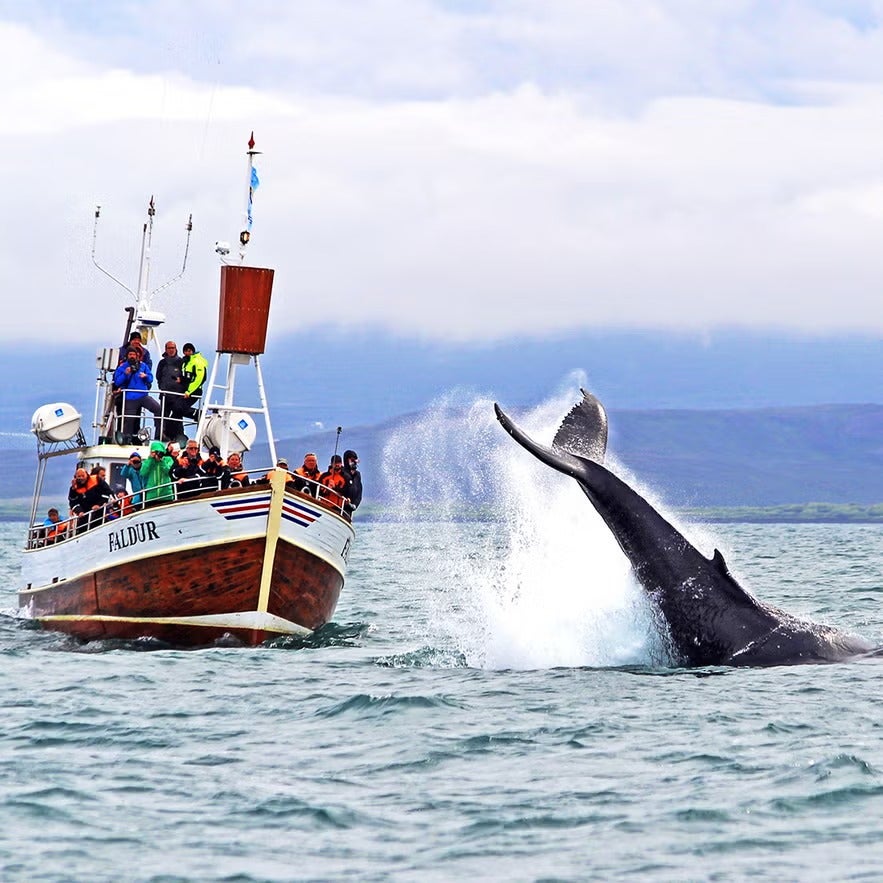
One of the most amazing things to do in Iceland is to join whale-watching tours. Whether you're staying in Reykjavik or visiting towns like Husavik, the whale-watching capital of Europe, you'll have incredible opportunities to see whales in their natural habitat. It's also common to spot dolphins and puffins in summer!
Whale watching in Iceland is a highlight alongside other activities like seeing the northern lights, bathing in hot springs, and hiking on glaciers. Depending on the season, you can spot whales under the midnight sun or beneath the northern lights. Read on to learn about the best spots for whale watching across Iceland.
Why You Can Trust Our Content
Guide to Iceland is the most trusted travel platform in Iceland, helping millions of visitors each year. All our content is written and reviewed by local experts who are deeply familiar with Iceland. You can count on us for accurate, up-to-date, and trustworthy travel advice.
- Learn more about Wildlife and Animals in Iceland
- Discover the Top 12 Best Activities in Iceland
Key Takeaways
-
Some of the most popular experiences in Iceland are the Reykjavik whale-watching tour and the Husavik whale-watching tour in North Iceland. They have high success rates for spotting humpback, minke, and orca whales.
-
Minke, humpback, and orca whales are common, with rare sightings of blue whales, sperm whales, and narwhals. You can also spot dolphins and puffins during summer.
-
Choose from traditional oak boats or modern RIB speedboats, with options for family-friendly and eco-friendly experiences.
-
Summer (April–October) offers better weather and more marine life, while winter provides fewer crowds and the chance to see orcas in the Breidafjordur Fjord.
The 5 Best Whale-Watching Tours in Iceland
A whale-watching tour can be an unforgettable experience, and plenty of enticing options are available for all enthusiasts.
Check out this list of whale-watching tours to explore current options. From traditional Icelandic oak boats to modern rigid inflatable boats (RIBs), you’ll find tours ranging from a few hours to full-day experiences.
The Icelandic puffin, which nests in large colonies on offshore islands and coastal cliffs, is often spotted during whale-watching tours. This means you can enjoy both whale watching and puffin sightings in one adventure.
If you’re visiting during the warmer months, combine your whale-watching tour with other top activities in Iceland including scuba diving and snorkeling. Consider this combo 6-hour whale-watching and river snorkeling tour to get more out of your vacation.
- Learn more about the Best Snorkeling Tours in Iceland
Looking for more tour ideas? Below is a list of the most affordable Iceland whale-watching tours, sailing from the country’s main whale-watching ports.
Reykjavik Whale-Watching Tour
-
Price: From 92 USD
-
Chances of seeing a whale: 99 percent
-
Availability: Year-round
-
Common species: Minke and humpback whales, whale-beaked dolphins, and harbor porpoises
Husavik Whale-Watching Tour
-
Price: From 85 USD
-
Chances of seeing a whale: 99 percent
-
Availability: April to November
-
Common species: Humpback whales, minke whales, blue whales, and white-beaked dolphins
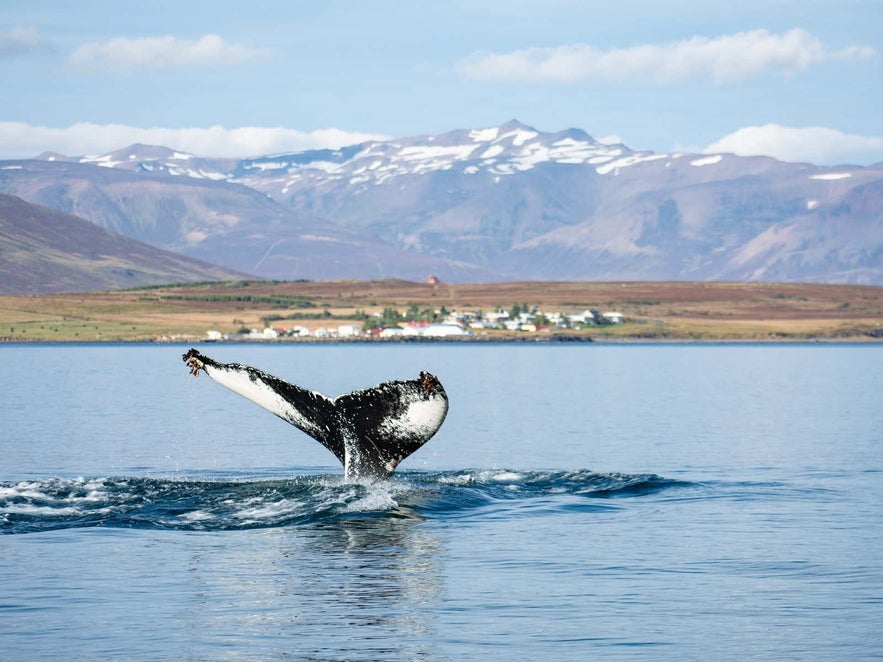
Akureyri Whale-Watching Tour
-
Price: From 99 USD
-
Chances of seeing a whale: 95 percent
-
Availability: Year-round
-
Common species: Humpback and minke whale, harbor porpoise, and white-beaked dolphin
Olafsvik Whale-Watching Tour
-
Price: From 99 USD
-
Chances of seeing a whale: 95 percent
-
Availability: February to September
-
Common species: Orcas, minke whales, harbor porpoises, white-beaked dolphins, and humpback whale
Hauganes Whale-Watching Tour
-
2-Hour Whale Watching and Sea Fishing Boat Trip With Transfer From Hauganes
-
Price: From 87 USD
-
Chances of seeing a whale: 99 percent
-
Availability: Year-round
-
Common species: Humpback and minke whale, harbor porpoise, and white-beaked dolphin
The Best Places To Go Whale Watching in Iceland
With Iceland being one of the premier whale-watching destinations, where exactly should you catch these adorable marine creatures? The answer depends on key factors, such as the:
-
Month you plan to visit
-
Types of whales you wish to see
-
Region you wish to explore
-
Type of whale-watching tour you wish to join
A good way is to identify the towns and cities hailed for their top-notch whale-watching adventures. Let’s take a look at the best ones below.
Whale Watching in Husavik
Husavik, often called the "Whale-Watching Capital of Iceland," is a must-visit destination. Located on the northern coast of Iceland, this charming fishing town boasts a rich marine life in Skjalfandi Bay.
The nutrient-rich waters attract various whale species, including humpbacks, minkes, blue whales, and even orcas.
One of the most popular ways to explore Husavik’s waters is through guided boat tours like this family-run whale-watching tour. Traditional oak boats and modern RIB tours provide different options to suit your preference for a relaxed or high-speed adventure.
Husavik tours come with experienced guides who enhance the experience. They provide valuable insights into whale behavior, marine conservation, and the surrounding landscapes.
Additionally, Husavik is home to the fascinating Husavik Whale Museum. This educational stop offers in-depth information about the history of whale watching, the biology of these creatures, and the importance of sustainable practices.
Whale Watching in Reykjavik
 Iceland’s capital, Reykjavik, is also one of the most appealing destinations for nature enthusiasts who want to see whales and other marine wonders. Through Faxafloi Bay, Reykjavik is a prime location to observe some of the ocean's most magnificent creatures in their natural habitat.
Iceland’s capital, Reykjavik, is also one of the most appealing destinations for nature enthusiasts who want to see whales and other marine wonders. Through Faxafloi Bay, Reykjavik is a prime location to observe some of the ocean's most magnificent creatures in their natural habitat.
Tours typically depart from the city’s Old Harbor, just a short walk from downtown, making it easily accessible for visitors. The waters around Reykjavik are home to various whale species, including minke whales, humpback whales, and sometimes even orcas.
You'll also often spot playful dolphins and curious porpoises, as well as various seabirds like puffins during summer. Hence, this whale and puffin watching combo boat tour from Reykjavik is a favorite among vacationers in the city.
Whale Watching in Akureyri
Known as the “capital of North Iceland,” Akureyri offers a unique whale-watching experience in Eyjafjordur, the country’s longest fjord. Its calm, sheltered waters are home to humpback, minke, and sometimes blue whales, providing smoother sailing conditions than open-ocean tours.
You can often find these magnificent creatures feeding, breaching, or playing near the boats, providing an awe-inspiring experience.
In addition to whales, you may encounter playful dolphins, seals, and a variety of seabirds, enriching the experience.
The fjord’s dramatic backdrop of snowcapped mountains and vibrant summer greenery makes every trip as visually captivating as it is exciting.
Whale Watching in Olafsvik
Olafsvik is a small fishing town with a rich marine ecosystem. Situated on the west side of the Snaefellsnes Peninsula, it is a prime location to spot an impressive variety of whales and other marine life.
One of the unique draws of Olafsvik is its frequent sightings of wild orcas, especially during the spring months. In addition to orcas, you may also see sperm and pilot whales. These nutrient-rich deep waters create an ideal feeding ground for these majestic creatures.
What sets Snaefellsnes Peninsula tours like whale watching in Olafsvik apart is the dramatic scenery. The towering Snaefellsjokull Glacier, volcanic peaks, and rugged coastline provide a stunning backdrop for your adventure.
Whale Watching in Holmavik
Whale watching in Holmavik is an unforgettable experience that connects you with the wonders of the North Atlantic. Nestled in the remote Strandir region in the Westfjords, Holmavik offers a peaceful setting to explore Iceland’s incredible marine life.
The pristine waters around this charming town are home to an array of whale species led by humpback and minke whales. You may even spot pilot, sperm, and killer whales if you’re lucky.
The calm fjords provide ideal conditions for spotting whales, often accompanied by dolphins and seabirds like puffins and arctic terns. The best time for whale watching in Holmavik is from May to September when the whales migrate to feed in the nutrient-rich waters of Iceland.
Tours like this 2-hour whale-watching adventure from Holmavik offer breathtaking views of dramatic cliffs and serene fjords. Local operators prioritize sustainability, ensuring minimal impact on marine life while providing an educational experience for visitors.
After your excursion, you can explore the quaint village of Holmavik, known for its fascinating Museum of Icelandic Sorcery and Witchcraft. Photography enthusiasts can capture the area's stunning beauty on dedicated photography tours, making it a perfect stop on your day trip around Iceland.
Whale Watching From Hauganes
Nestled along Eyjafjordur, Iceland’s longest fjord, Hauganes provides a peaceful and picturesque backdrop for observing whales in their natural habitat. This charming fishing village is home to some of Iceland’s oldest whale-watching tours, renowned for their intimate, eco-friendly excursions.
The calm waters of Eyjafjordur are a haven for different whale species, including humpback, minke, and occasionally blue whales.
These gentle giants often surface near the boats, offering incredible opportunities for photographs and awe-inspiring memories.
Hauganes is also unique for its small-group adventures, like this exciting 2.5-hour whale-watching tour. After your adventure, you can savor the calming environment of Hauganes, stroll along the shoreline, or visit a local fish restaurant to sample Icelandic food.
Whales of Iceland
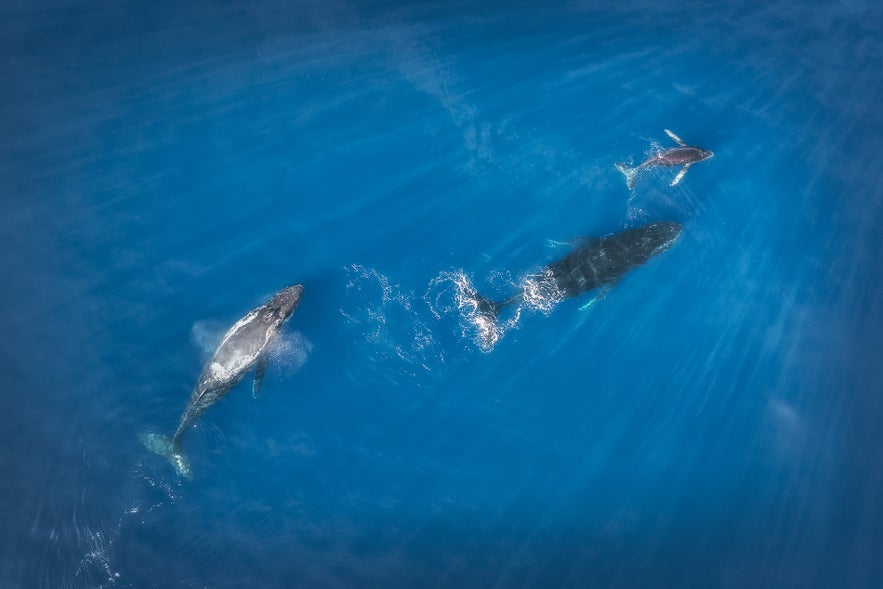
Iceland’s waters attract 24 whale species, from sperm whales to harbor porpoises, thanks to a mix of cold and warm sea currents. Minke whales are the most commonly spotted and appear year-round.
Whales have been an important part of Icelandic history for over 1,000 years. The word "hvalreki," which means "beached whale," also refers to an event that was once seen as beneficial, as these whales provided a valuable food source for local communities.
Minke Whales
Minke whales are the most common whales in Iceland’s waters, with many migrating here throughout summer and a few lingering through the winter months.
They're small compared to other species but can still exceed 30 feet (9 meters) in length. Their behavior is usually rather shy, but due to their numbers, you can regularly see them from almost all whale-watching ports, including Reykjavik.
Humpback Whales
Humpback whales can be seen in Iceland during the summer months, making it a great opportunity to plan summer tours in Iceland.
Unlike minke whales, humpbacks are renowned for their gregarious and acrobatic behavior. You could say that humpback whales are the attention-seeking divas of the whale world.
They are a common sight on whale-watching tours, breaching, feeding, or slapping their tails and flukes.
Tour operators from northern towns, such as Akureyri and Husavik, have had seasons in which they have spotted at least one humpback on every excursion.
White-Beaked Dolphins
White-beaked dolphins are the most commonly seen dolphins around Iceland, staying close to the shore throughout the year.
They live in pods ranging from a few individuals to a hundred, and though a bulky species, you can often see them bow-riding, breaching, and playing at the surface.
Not only can you see these dolphins swimming in Iceland's waters, but they can also be seen on Icelandic currency, specifically the 5-krona coin. So if you're lucky enough to see them on your whale-watching tour, you can keep the coin as a (rather cheap) souvenir.
Harbor Porpoises
Photo from Wikimedia Commons Library. No edits made.
The adorable harbor porpoise is one of the smallest whale species. It can be seen widely in Iceland's waters throughout the year. However, you might need someone with a trained eye to point them out.
They're small and shy and usually only appear at the surface, alone or in small groups, for moments at a time. When feeding or threatened, they can race across the surface while splashing their tail, in a behavior known as roosting. It's a dramatic and eye-catching display and would make any whale-watching trip memorable.
Orcas
Despite being called killer whales, orcas are the world’s largest dolphin species. About 5,000 of them live around Iceland throughout the year, coming closer to the shore during the summer months.
Orcas can appear on whale-watching trips but are not as easy to find as other species due to their transient nature. However, their great size and occasional acrobatic behavior make them a favorite among whale watchers.
Orcas, sometimes called the "wolves of the sea," are voracious eaters and require 400-750 pounds (175-350 kg) of food every day. In Iceland's waters, they mainly feed on herring and capelin.
If you're eager to go orca watching in Iceland, they're most common in the Eastfjords' rich herring grounds, around the Snaefellsnes Peninsula, and along the South Coast.
Orcas are especially beloved in Iceland because of Keiko, a well-known orca that was born in Iceland's waters and later became a star of the silver screen!
The species above are the ones you're most likely to see on a whale-watching tour in Iceland. However, a wide array of Icelandic whales can occasionally appear in the island's waters. Below is a list of other species that the most fortunate will have the opportunity to see.
Blue Whales and Fin Whales
Humpback and minke whales are the most common baleen whales in Iceland's waters, but they aren't the only ones you might spot.
Blue and fin whales, the two largest animals on Earth, also occasionally appear during the summer.
-
Blue whales: These giants can grow up to 100 feet (30 meters) long and weigh up to 165 tons (150 tonnes). Despite their size, they feed almost exclusively on krill. Their life span is similar to humans, averaging 80 to 90 years.
-
Fin whales: The second largest creatures on Earth, fin whales average 65 feet (20 meters) in length and weigh 36.29 to 45.36 tonnes. They appear more often than blue whales, with 30,000 to 40,000 living in the North Atlantic.
Sperm Whales
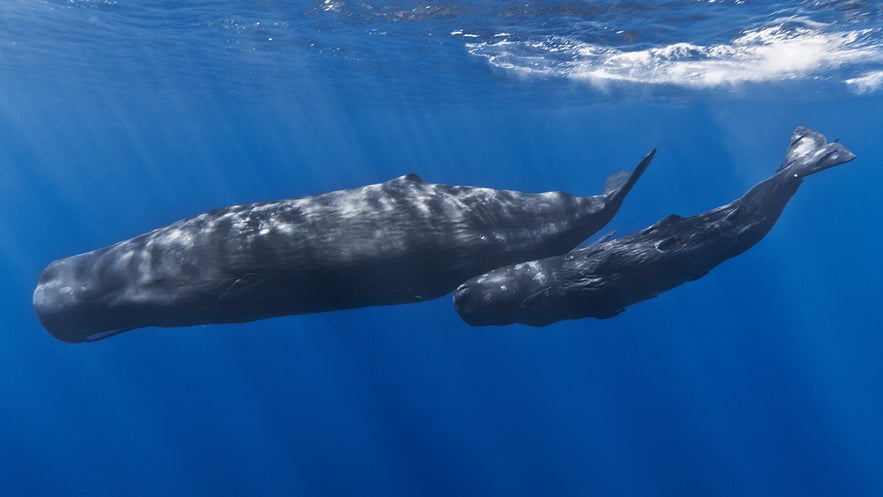
Photo by Gabriel Barathieu from Wikimedia Commons Library. No edits made.
Sightings of the largest toothed whale, the mighty sperm whale, are not uncommon off Iceland’s West Coast in spring and summer. There are about 23,000 individuals in the sea around Iceland and the Faroe Islands.
Despite the relatively large size of its population, they are rarely spotted since they can hold their breath for an extraordinarily long time. The sperm whale can hold its breath for up to two hours, surfacing only once or twice during a whale-watching tour in Iceland.
Beluga Whales and Narwhals
Photo from Wikimedia Commons Library. No edits were made.
Groups of belugas and narwhals have occasionally appeared in northern Icelandic waters even though their usual habitat is around Greenland, within the Arctic Circle.
Narwhals are famous for the male's tusk, which is, in fact, a long canine tooth. The long tusk is not necessary for survival and serves a similar purpose to the antlers of a stag or the feathers of a peacock as an assessment of hierarchical status.
Beluga whales are closely related to narwhals and belong to the same family of whales. Similar to narwhals, beluga whales spotted in Iceland are stragglers as their natural habitat is further north in the Arctic Circle.
The Westman Islands are home to the world's first beluga whale sanctuary, where visitors can meet two female whales, Little White and Little Grey, in their new home in SEA LIFE Trust Beluga Whale Sanctuary.
Long-Finned Pilot Whale
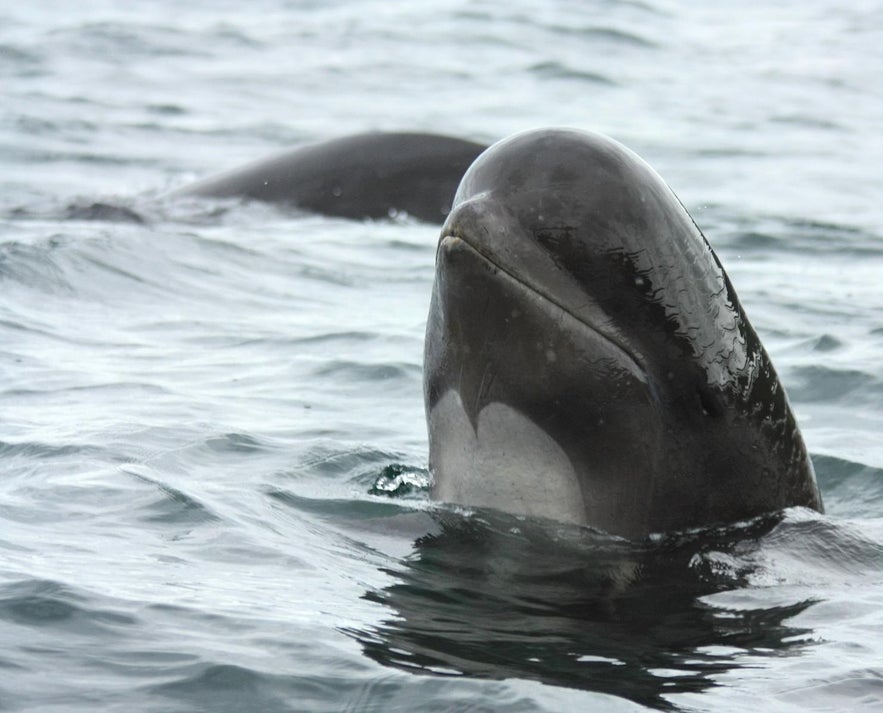
Despite its name, pilot whales are actually a species of large dolphins. They are noticeable for their unusually long pectoral fins.
There are about 350,000 pilot whales in the North Atlantic alone. However, they are a very transient species that spend most of their time offshore, so they are not seen in Iceland's waters as much as you might expect.
When Is the Best Time for Whale Watching in Iceland?
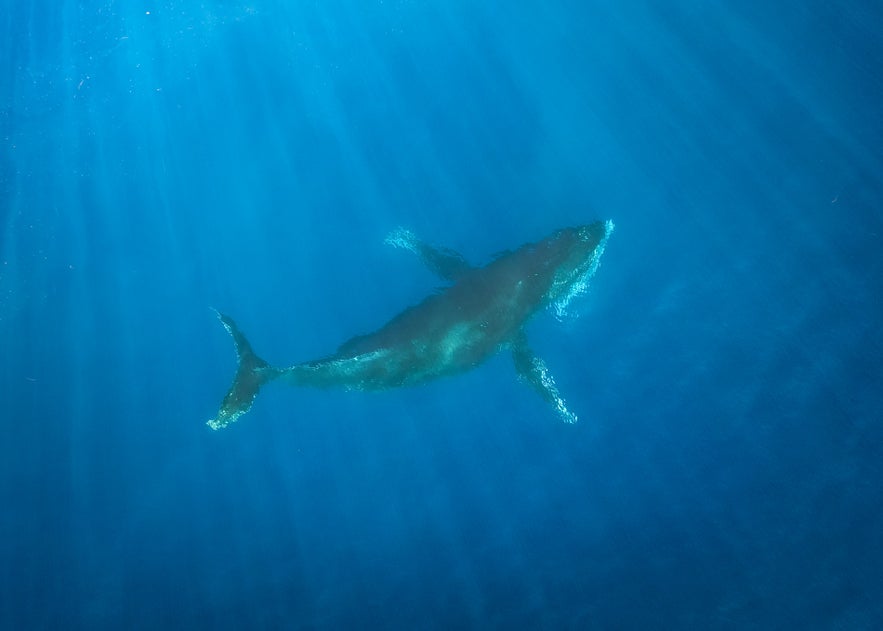
You can enjoy whale-watching tours throughout the year, but the experience can differ depending on the whale-watching season.
There are advantages to Iceland whale-watching in summer over winter, and vice versa, that you should consider before booking your trip. Let us break it down for you.
- Learn more about When Is the Best Time To Visit Iceland?
- See also How Many Days To Spend in Iceland
Whale Watching in Iceland in Summer
Whale watching in summer has one obvious appeal over whale watching in winter—the weather in Iceland is better.
With calmer winds, fewer storms, and clearer skies, whale-watching tours have fewer cancellations, and your chances of seeing cetaceans breaking the flat surface of the water are much higher.
Furthermore, standing on the deck for the tour's duration is a lot more enjoyable.
However, the balmier weather is not the only reason whale watching in summer has advantages over whale watching in winter. The second main draw is the greater diversity of marine life.
The migratory baleen whales of the world’s oceans tend to spend their winters around the equator breeding and summers closer to the poles to feed.
As a result, between April and October, you can expect to see some of the world's largest creatures on your whale-watching tour in Iceland.
No matter the port you leave from in summer, you have an excellent chance of seeing minke and humpback whales.
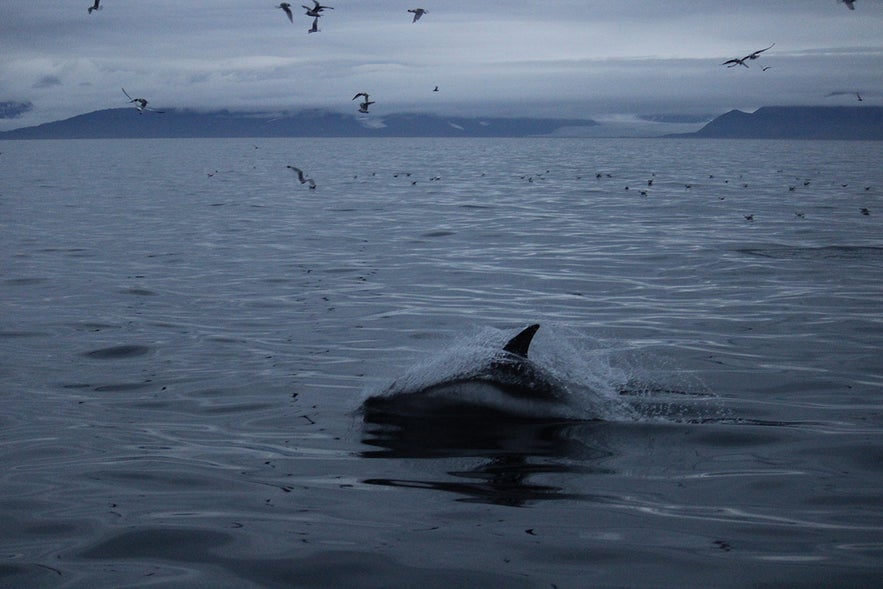
Photo from Wikimedia Commons Library. No edits made.
Though they prefer deeper water than those in Faxafloi Bay, sperm and northern bottlenose whales are also more commonly found in Iceland in summer.
You can often see sperm whales in Breidafjordur Bay, where the water is deep enough for them to hunt. Northern bottlenose whales are more randomly distributed offshore but occasionally come into shallower seas when pursuing prey.
However, these are not the only whale species that come to Iceland in summer, making each whale-watching tour spectacular.
Basking sharks, the second largest fish species, also occasionally cruise near the surface during this season.
These enormous, prehistoric creatures move slowly and have a very calm nature, meaning sightings often last longer than with the whales, who dive to feed.
In addition to whales, you can see birds such as arctic terns, great skuas, and puffins on tours from Reykjavik, Akureyri, Husavik, and the Snaefellsnes Peninsula. They're frequently spotted bobbing on the water's surface, circling overhead, or diving for fish.
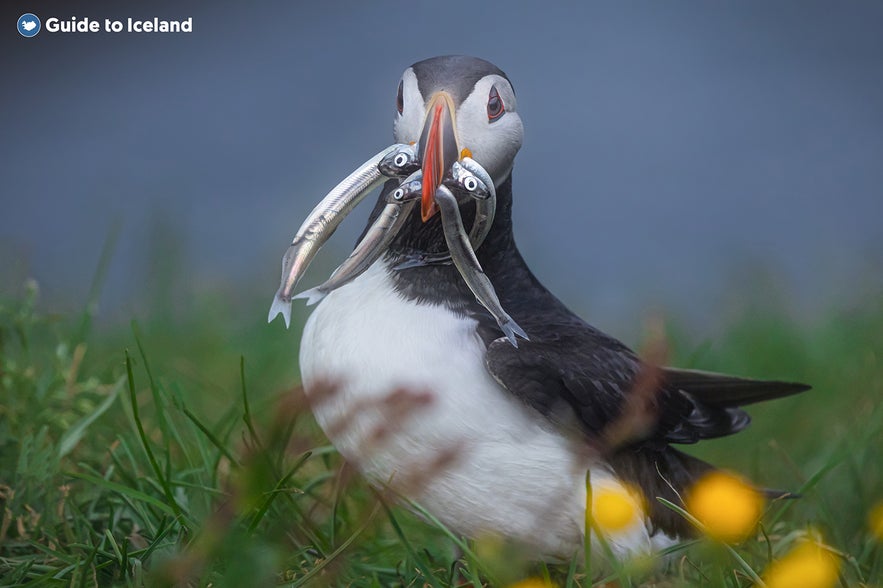
Another advantage of whale watching in the summer is that you can partake in a smaller vessel, such as a RIB, for a much closer, more personal encounter. If you want a RIB boat experience, the best options depart from Reykjavik or Husavik—like this 2-hour puffin and whale-watching boat tour from Husavik.
Whale Watching in Iceland in Winter

Despite the many advantages of summer whale-watching tours, going whale-watching in the winter also has its benefits.
First, winter tours in Iceland including whale-watching tours are much less busy. Summers are high season for the number of visitors in Iceland, making whale watching in the winter less crowded.
If you don't mind bracing cold winter conditions, you will likely have a lot more space to search for sea mammals and spot them from the viewing deck when they do appear.
Regarding the cetaceans you’ll see on winter whale-watching tours, the most common are white-beaked dolphins and harbor porpoises.
However, it's not unheard of for great whales to occasionally linger throughout winter, so it’s reasonable to hope to see minke whales and occasionally humpbacks.
The second advantage of whale watching in winter applies solely to whale watching in certain areas. Breidafjordur Bay, between the Westfjords and the Snaefellsnes Peninsula, is a herring wintering ground, and the abundance of food attracts many predators.
Therefore, orcas, the apex predator of the ocean around Iceland, are more common in Breidafjordur in the winter than in the summer.
The herring in Breidafjordur also means that humpbacks who linger throughout winter will often congregate there.
Meanwhile, in North Iceland, you are far more likely to see belugas than you would be during summer.
While these curious, gregarious animals are common in Iceland's waters and only come here by chance, this occurs when they have migrated away from the Arctic into waters with less ice.

A final advantage of whale watching in winter is that it allows you to experience some incredible nature, regardless of the wildlife you may encounter.
Searching for whales in Iceland while surrounded by the snowy mountains of Eyjafjordur Fjord, for example, makes the scene even more spectacular and will make the sighting of a whale all the more dramatic.
There’s also the slight chance to see the northern lights on a winter whale-watching tour, which would be an unforgettable experience.
Should You Experience Iceland Whale Watching During Summer or Winter?
Wondering when you can see whales in Iceland? Whale watching is usually more enjoyable, successful, and rewarding during summer.
The exception to this is on tours from the Snaefellsnes Peninsula due to the success rates of seeing orcas.
Regardless, excursions from shore go on throughout the year for a good reason—you may be able to see these majestic creatures from land. Iceland has an abundance of cetaceans you can reliably see, irrespective of the whale-watching season. So whichever season you travel in, you’ll have a wonderful Iceland experience.
- See also Iceland's Seasonal Contrasts
Where Is the Best Place for Whale Watching in Iceland?

The time of year you decide to go whale watching and the port you choose to depart from on a whale-watching tour will affect what you see.
Different species frequent different areas, so if you seek to see a particular animal, you should know the best places in Iceland to go.
The town of Husavik in North Iceland is dubbed “the whale-watching capital of Europe,” but there are plenty of other places to take a whale-watching tour.
Reykjavik Whale Watching
If you stay in Iceland's capital city, embarking from Reykjavik’s Old Harbor is the easiest option.
The usual departure point is within easy walking distance from most downtown hotels. As tours tend to last three hours or less, they allow you to enjoy an incredible experience without taking up a decent chunk of your day.
This length also means that if a tour is canceled due to inclement weather or if you didn’t see any whales, you might be permitted to join another tour for free. This arrangement is unlikely to mess up any other plans for those staying in the capital, like those at Alda Hotel Reykjavik.
The convenience of whale watching in Faxafloi Bay is undoubtedly part of its appeal, but it’s not the only lure. In clear weather, you should be able to see a vast amount of iconic Icelandic sites on a tour from Reykjavik.
To the south, you’ll see the cone-shaped volcanoes that line the barren Reykjanes Peninsula. Whereas to the north, it’s often possible to see Snaefellsjokull Glacier in the distance.
Furthermore, Faxafloi is a reliable place to find white-beaked dolphins, harbor porpoises, and minke whales throughout the year.
In summer, humpbacks are common, and because they nest in the thousands on the islands of Lundey and Akurey, you can spot puffins on almost every outing.
Whale Watching in North Iceland
North Iceland whale-watching tours that leave from Akureyri and Husavik into Eyjafjordur and Skjalfandi Bay, respectively, have the highest success rates in Iceland.
Tour operators from both locations experience sightings on 100% of tours in summer, the main appeal being humpback whales. The wealth of food in the cold northern waters draws them into the fjords, the depths of which still allow them to dive to hunt.
However, humpback whales are not the only common species. As with the rest of the country, harbor porpoises and white-beaked dolphins also frequent the waters.
North Iceland is also the best place to get your chance to spot some of the lesser-seen whales.
Blue and fin whales also come there seeking food, although rarely, so do stray beaked whales, narwhals, and belugas.
All 24 species of cetacean you can find in Iceland’s waters have been seen in the north, something no other part of the country can claim.
Skjalfandi has a higher number of cetaceans than Eyjafjordur. This means more chances of sightings and watching exciting behaviors such as breaching, fluking, tail-slapping, and spy-hopping.
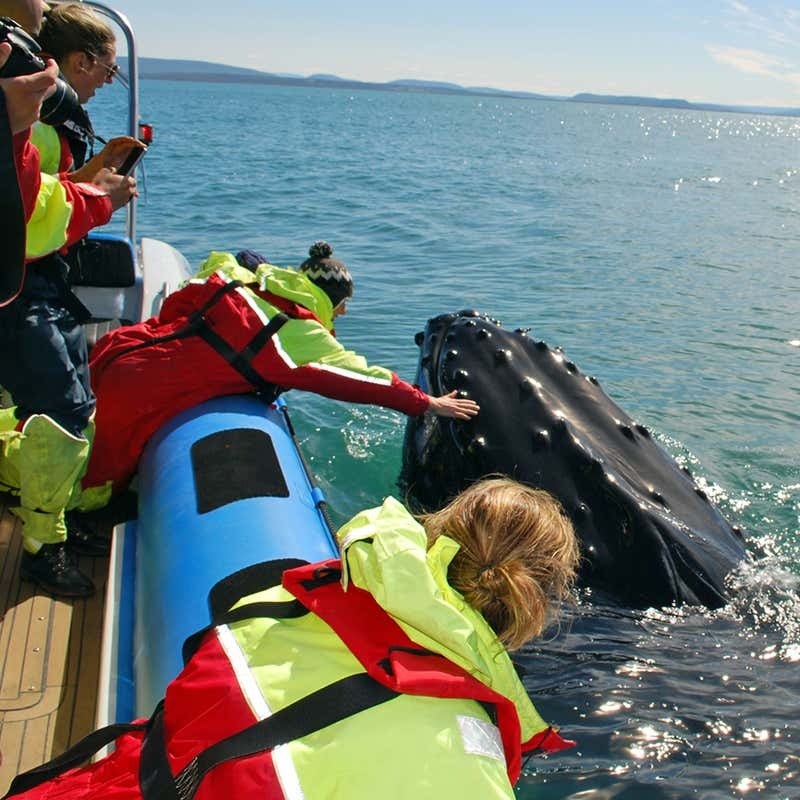
Meanwhile, Akureyri is simply a more convenient place to go whale spotting. It's the largest town outside of the capital region, meaning it has more activities and sites you can fill your day with when your whale watch is complete.
That being said, Husavik’s services have grown with the rising number of visitors over the past decade, so this difference may soon become negligible.
Whale Watching From the Snaefellsnes Peninsula
The Snaefellsnes Peninsula is better known for its excellent sites on land than for its sea life, but avid whale watchers will find it a hidden gem.
Tours leaving from Olafsvik take you into Breidafjordur, which, as mentioned, is a wintering herring ground that attracts dolphins, porpoises, humpback whales, and, most uniquely, orcas.
Orcas live all around Iceland but tend to be transient. They move where the food goes. Therefore, they're rarely seen in other parts of the country, particularly in Faxafloi Bay.
While you can see them most commonly in winter, Breidafjordur is also well worth visiting in summer, as it's the best place in the country to find sperm whales.
Taking tours from the Snaefellsnes Peninsula also allows you the chance to see pods of pilot whales, which can number in the hundreds.
Though these animals are abundant around Iceland, they tend to hunt offshore, so they're a rare sight. However, it should be noted that even in Breidafjordur, this is not a common occurrence.
The Verdict?
The best whale watching in Iceland is undoubtedly out of Husavik. That being said, each whale-watching port has unique factors that may override the quality of the whale-watching experience in Husavik.
However, Reykjavik and Akureyri are more convenient for location and time management, considering most people joining whale-watching tours are on holiday and want to pack in as many different activities each day as possible.
For avid whale watchers who want to see less commonly spotted animals around the world, a tour from the Snaefellsnes peninsula wins out.
Whales in Icelandic Folklore and Sagas
Throughout Iceland's history, whales have had, in some cases, positive connotations, such as the Icelandic word for a stroke of good luck.
That's because, in the harsh conditions of medieval Iceland, where food was hard to come by, a beached whale was incredibly fortunate as it meant an abundance of food that could last throughout the winter.
In other cases, they were considered terrifying creatures with many folkloric stories surrounding menace.
The map above shows 16th-century depictions of the many sea creatures thought to live in Iceland's waters. Interestingly, each creature is marked with a letter from the alphabet, corresponding to a compendium that details information about the creature.
Some of these creatures are actually well-known whale species. For example, the creature marked L is supposed to be a blue whale, while the creature marked C depicts a sperm whale.
In Icelandic folklore, there are many stories of the so-called "illhveli," which literally translates to "evil whale." These whales were said to have evil intent and deliberately stalked and tried to sink boats by tipping them over.
The most evil of the "illhveli" was Raudkembingur, a type of whale with a spiky reddish comb along his head. This whale was said to have a thirst for killing and wrecking ships. Below, you can see a depiction of a Raudkembingur from a 17th-century manuscript.
Evil whales are a surprisingly common occurrence in Icelandic stories. As early as in the Heimskringla saga of King Olaf Tryggvason, it's written that when the devious King Harald Bluetooth was planning to invade Iceland, he had a sorcerer take the form of a terrible whale who was to locate the island’s points of vulnerability.
But each time the whale-sorcerer attempted to land ashore, the four landwights of Iceland—the dragon of the east, the eagle of the north, the bull of the west, and the stone giant of the south – sent him cowering back to the sea, rendering the invading king's efforts futile. These four landwights are depicted on Iceland's coat of arms.
Whales aren't the only sea creatures common in Icelandic folklore. Seals are also featured prominently in stories about selkies, creatures who can shed their sealskin and become human.
Although countless legends tell remarkable tales of the meetings between Icelanders and magical whale-like creatures, the first official Icelandic whale-watching ship didn't leave port until 1991, carrying under a dozen curious passengers seeking a personal encounter with the gentle giants of the sea.
- Learn more about Seal Watching in Iceland
Keiko the Killer Whale
The most famous whale to grace Icelandic waters is not a magical creature of medieval literature but an aquatic star of Hollywood blockbusters.
Keiko, the male orca who portrayed Willy in the 1993 hit film "Free Willy," was captured in Reydarfjordur Fjord in East Iceland in 1979 and was originally named Siggi.
He was subsequently bought and sold between various aquariums and marine parks, where he learned to perform for audiences before being cast by Warner Bros. Studios.
Following Keiko’s rise to stardom, The Free Willy-Keiko Foundation was established in 1995 to find him a better home. In 1998, the world looked on in amazement as Keiko was loaded aboard a C-130 U.S. Air Force cargo plane and flown from the United States back home to his birthplace in Iceland.
Keiko would finally be allowed to swim in the ocean again, hoping he would eventually reunite with other killer whales.
Keiko spent the following years in Klettsvik Bay of the Westman Islands, where he underwent extensive training in preparation for a life of freedom on the open seas.
In August 2002, Keiko finally left Icelandic territorial waters with a group of wild killer whales, but in September, he showed up in a fjord in Norway, desperately seeking human contact.
Keiko’s reintegration into the wild had failed, and on December 12 of the following year, Keiko died of pneumonia while swimming alone in Norwegian waters. He was 27 years old.
No single marine animal has brought more attention to the whales of Iceland than Keiko. Since his passing, whale watching in Iceland has rapidly grown into a flourishing industry.
In 2018 alone, nearly 300,000 people took whale-watching trips from Icelandic harbors—quite a leap from the first tour of less than a dozen people in 1991.
Keiko's former home in Klettsvik Bay now hosts permanent residents again—two beluga whales, Little Grey and Little White. They were brought from an amusement park in Shanghai to live in the newly named Beluga Whale Sanctuary, where they arrived on June 20, 2019.
You can also book admission to the Beluga Whale Sanctuary and Puffin Rescue.
Commercial Whaling in Iceland
Paradoxically, the old whaling vessels in Reykjavik Harbor are anchored at the dock on which Iceland's largest whale-watching society operates.
Whaling has been practiced in Iceland from as early as the 12th century. Despite Keiko's popularity and the recent surge in whale-watching tourism, Icelanders remain one of only a handful of nations on Earth that still hunt and kill whales.
In 1986, Iceland’s whaling industry became the subject of worldwide scrutiny when antiwhaling activists sank the whaling vessels Hvalur 6 and Hvalur 7, which made up half of the Icelandic whaling fleet.
The incident sparked a fierce international debate between various radical and moderate animal rights organizations.
The outcome of that debate was not in the anti-whalers' favor. Most environmentalists denounced the tactics as too extreme, with some going as far as branding the incident as an act of terrorism.
Domestically, public opinion immediately swayed in favor of the whaling industry, with the general population viewing the incident as a gross outside intrusion into domestic affairs.
The two sunken vessels were promptly raised, and for several years, whaling continued, backed by even greater public approval than before.
However, with the rise of the Icelandic whale-watching industry, whaling is becoming less popular among the general Icelandic population, with whale meat in Iceland mostly eaten by curious tourists.
FAQ's About Whale-Watching in Iceland
Haven't found your answer? Here are some of the most frequently asked questions about Iceland whale watching.
Is whale watching worth it in the fall (September–October)?
Yes, fall is still a good time for whale-watching in Iceland. Many migratory species, such as humpback and minke whales, are still present in the waters before heading south, and tours tend to be less crowded than in peak summer months.
Can you see whales in spring in Iceland (March–May)?
Spring marks the return of migratory whales to Icelandic waters, making it an exciting time to spot early arrivals like humpbacks. While sightings are generally fewer than in summer, the chances improve steadily from April onward.
What should I wear on a whale-watching tour in Iceland?
Dress in warm, layered clothing, including a waterproof outer layer. Recommended items include thermal underlayers, insulated jackets, warm gloves, hats, and sturdy waterproof footwear. Even in summer, temperatures at sea can be chilly!
What types of boats are used for whale-watching tours in Iceland?
Tours utilize various vessels, including traditional oak boats and modern RIB (rigid inflatable boat) speedboats. Oak boats offer a stable and comfortable ride, ideal for families, while RIBs provide a more adventurous experience, getting closer to the whales.
What happens if no whales are spotted during the tour?
While sightings are common, they can't be guaranteed. Many operators offer complimentary tickets for another tour if no whales are seen.
Ready To Embark on Your Whale-Watching Adventure in Iceland?
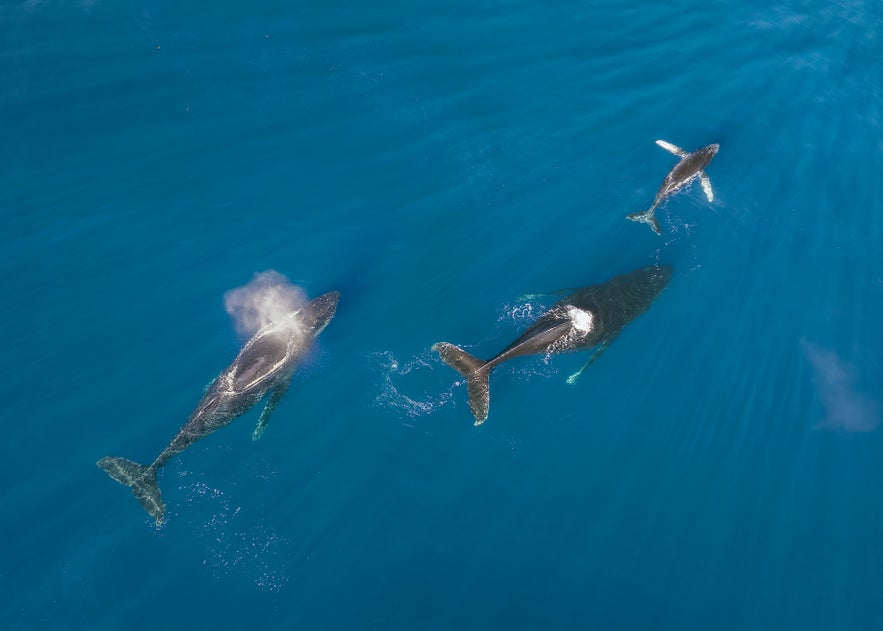 Whale watching in Iceland offers an unforgettable experience, with a variety of tours available to suit all preferences. As the popularity of whale watching continues to rise, it's an exciting and sustainable way to connect with nature.
Whale watching in Iceland offers an unforgettable experience, with a variety of tours available to suit all preferences. As the popularity of whale watching continues to rise, it's an exciting and sustainable way to connect with nature.
Check out the tours mentioned above, book early, and consider combining your whale-watching adventure with a puffin viewing for the perfect Icelandic experience.
For a tailored experience, explore whale tours from Reykjavik to see majestic whales and the iconic puffins in one trip.
Do you have more questions on planning your whale-watching trip in Iceland? Want to share tips about an experience seeing whales in Iceland? Add your comment below to get answers or help other travelers!



